The Aesthetics of Anthropocene Public Space
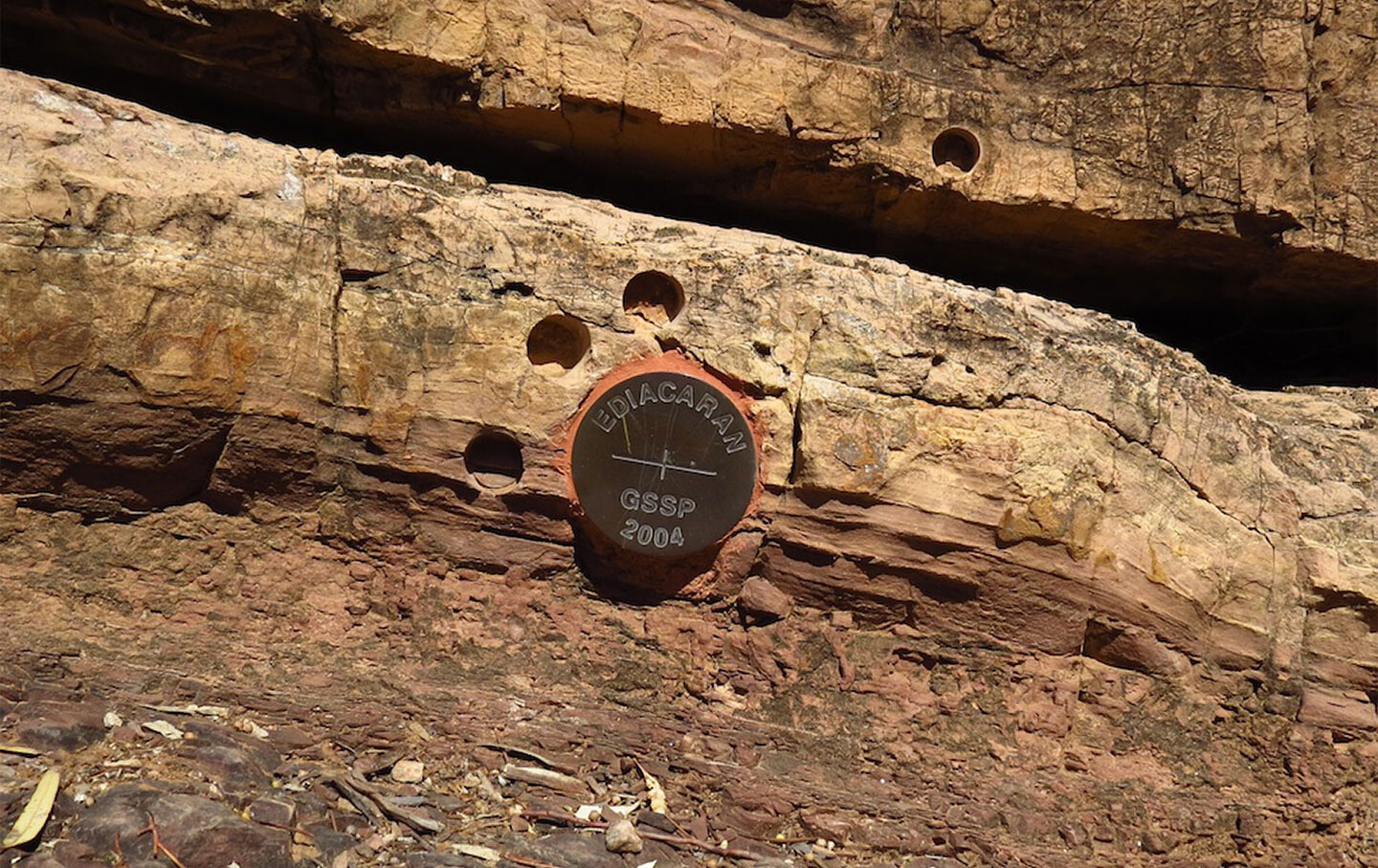

By now technology has become as much a part of life as metabolism.
—László Moholy-Nagy1
Global environmental change is usually approached through abstract scientific measures, such as the rising atmospheric concentration of CO2 (“410 parts per million”). Similarly, the agency of global change is ascribed to an abstract figure of Humanity, introduced with a capital letter (the “Anthropos” who just made the planetary scene). In this text I’m not going to argue against the global scale, or against scientific abstraction, or against the Anthropocene. Instead I’m going to make a complementary move, which is to turn the analytical lens to the metropolitan scale, where individuals and groups confront the processes, products, organizations, and institutions of the present era. Could it be that all the abstract drivers of global environmental change—things like Science, Technology, Capitalism, and Militarism—are internalized, reworked, and expressed anew on the metropolitan territory? Such a scale (say, a dense urban core plus its adjacent suburban-industrial sprawl) remains large enough to encapsulate the entire toolkit of contemporary industrial civilization. At the same time it constitutes a very tangible arena in which to act as a citizen, a member of a social movement, an intellectual, or a revolutionary. Yet one thing is still lacking. For such action to become significant in the terms of contemporary ecological debates, the metropolitan scale has to be made affectively sensible and recognizable as something quite new: namely, as Anthropocene public space. I’m going to argue that this transformation is an aesthetic operation. To understand how it works, one can do as the proponents of the Anthropocene have done, and take a cue from the stratigraphers.
The placement of a “golden spike” is a public documentary practice in contemporary geology. Technically known as a Global Stratotype Section and Point, or GSSP, the golden spike is a marker inserted into an exposed sedimentary stratum. It is literally driven into the rock at the lowest level where a fossil characterizing a given geological period can be observed. You can go see it, anyone can. Present to the senses when they are sharpened by knowledge, the rocky outcropping itself becomes exemplary of an epoch’s fossil signature and its place in earth’s history. Yet the golden spike does not just record a singular fact, nor even just a complex of local or regional observations. Instead, its placement is correlated with observations across the planet, so that the periodization it exemplifies can be recognized by anyone anywhere. As one expert notes: “Before formally defining a geochronologic boundary by a GSSP, its practical value—i.e. its correlation potential—has to be thoroughly tested. In this sense, correlation precedes definition.”2 Within the scientific community, this activity of correlation is taken on by the International Commission on Stratigraphy. A subgroup of that commission continues to debate whether, how, and where to establish the boundary point at which the current geological epoch (the Anthropocene) can be distinguished from the previous one (the Holocene).
Don’t we need more subgroups like that, of many different kinds? What I want to explore in the metropolitan context—taking the example of Chicago where I live—are experiments in perception, expression, and action that use aesthetic means to characterize the present epoch. These experiments begin in the partially abandoned industrial zones of the city, where the core functions of metropolitan technology receive almost no public attention. At issue are the processes whereby oil is turned into the energy of our lives, with multiple unwanted consequences. The cast of characters includes inhabitants, machines, landscape features, animals, ruins—an entire political ecology continually probed by techniques of measurement and analysis, and overlaid with logics of governance and control. The scales extend from the intimate to the continental and the global. The aim is to discover at least some of the pathways that could lead to the constitution of Anthropocene public space, by which I mean a tactile, practical, widely sharable confrontation with the human-generated forces that are transforming our biosphere.
Anthropocene public space is not any single place, forum, or monument, but a condition of relational awareness springing from an exercise of the perceptual and expressive faculties. Its territorial envelope is not the town square or historical center but the metropolis: the scale at which global processes are internalized, reworked, and projected into circulation anew. Its political coordinates include colorless, odorless aspects of our ecological predicament, like CO2 itself; and for that reason its direct experience depends both on the precise knowledge offered by laboratory experiments and on abstract theoretical frameworks. However, the concept of a democratic public space requires broad participation, and therefore, multiple forms of access to issues of shared concern. This means that the experience of such a space must also be aesthetic. That’s what I am concerned with here. For Anthropocene public space to exist in any significant way, its proponents will have to grapple with and ultimately replace the currently dominant aesthetic regime.
How can the multiple causalities of climate change be experienced first hand, to produce the power of conviction conveyed by direct perception? How can such experiences be correlated with those of others, whether near or far? How to found a new public space in which convictions have consequences? How to drive the golden spike signifying to everyone our transition to an accelerated time when human-generated energies are, as the climate scientists say, “overwhelming the great forces of nature?”3


László Moholy-Nagy, Light Prop for an Electric Stage, 1930.
Map and Territory
An aesthetic is inherently double, at once an expressive repertoire and a recognizable complex of sensations. Its relational nature implies the spatial dimension where human beings meet through the mediation of artistically transformed objects or gestures. It also takes a midstream position in time, building on latent, forgotten, or repressed potentials in order to break through contemporary norms and open up possible futures. To give an idea of what an aesthetic of Anthropocene public space could look like and do, I’ll start by reflecting back on a major aesthetic proposal that was formulated in Chicago during World War II, amidst the technological and organizational explosion that is now called the “Great Acceleration.”4 The keyword of this proposal was “vision in motion,” developed in a book of that name by the Hungarian emigré artist and teacher László Moholy-Nagy. It emerges from the core of Bauhaus experimentalism in the 1920s and gains new significance through the encounter with the rapidly changing conditions of life in North America. An important offshoot runs through Moholy’s friend and disciple György Kepes, to the science and engineering culture at MIT and the dominant interface aesthetic of the present.
A constructivist working with painting, photography, film, and light-modulating sculpture, Moholy was a key figure in the Bauhaus, close to the school’s founder, Walter Gropius. Driven from Germany by the Nazis, he came to Chicago in 1937 to found the New Bauhaus, later renamed the Institute of Design. His aim was to bring the immediacy of vanguard experimentalism into constructive interplay with the rapidly changing technological materials of industry, so as to articulate a cultural basis for the full spatial range of modern experience. “All creative work today,” he believed, “is part of a gigantic, indirect training program to remodel through vision in motion the modes of perception and feeling and to prepare for new qualities of living.”5 As he further explained:
It is the artist’s duty today to penetrate yet-unseen ranges of the biological functions, to search the new dimensions of the industrial society and to translate the new feelings into emotional orientation. The artist unconsciously disentangles the most essential strands of existence from the contorted and chaotic complexities of actuality, and weaves them into an emotional fabric of compelling validity, characteristic of himself as well as his epoch.6
Thus the aesthetic of “vision in motion” aspired not only to kaleidoscopic renderings of the multiple perspectives offered by automobile travel, airplane flight, and other forms of technological acceleration, but above all, to the constitution of an inner compass or gyroscope for the tumultuous journey of modernization.
In this regard, Moholy was sharply critical of the society around him. Having witnessed the failure of the European nations to overcome the antiquated ideologies and class divides that led to brutal war for industrial advantage, he now foresaw the damage that would result from the replacement of consciously manipulated tools by rapidly obsolescent convenience products delivered within a framework of managed consumption. Corporate profits built on deliberate waste would lead to psychic and social decay, which the highly specialized professionals of industrial development would remain unable even to sense, let alone communicate to those around them. To press this issue, Moholy refers to the general semantics of Alfred Korzybski, who is chiefly remembered for the idea that “the map is not the territory.” In Science and Sanity (1933), Korzybski stressed the importance of transforming the linguistic abstractions of the brain’s upper cortex back into the intuitions, feelings, and visualizations that create a bond between the conceptual “map” and the underlying “territory.” This was a live debate in Chicago, where Korzybski himself lived and worked. Moholy quotes a contemporary interpreter of Korzybski, Oliver Bloodstein: “By re-translating our higher order verbal abstractions of relations and order into simplified but direct manifestations which can be visualized and felt, modern art affords immediate subcortical experience of essential structure.” Moholy adds: “I question only the biological justification of distinguishing between ‘higher’ and ‘lower’ orders of experiences. Biologically seen, they are of equal order and without their balanced, interpenetrated performance no satisfactory life exists.”7
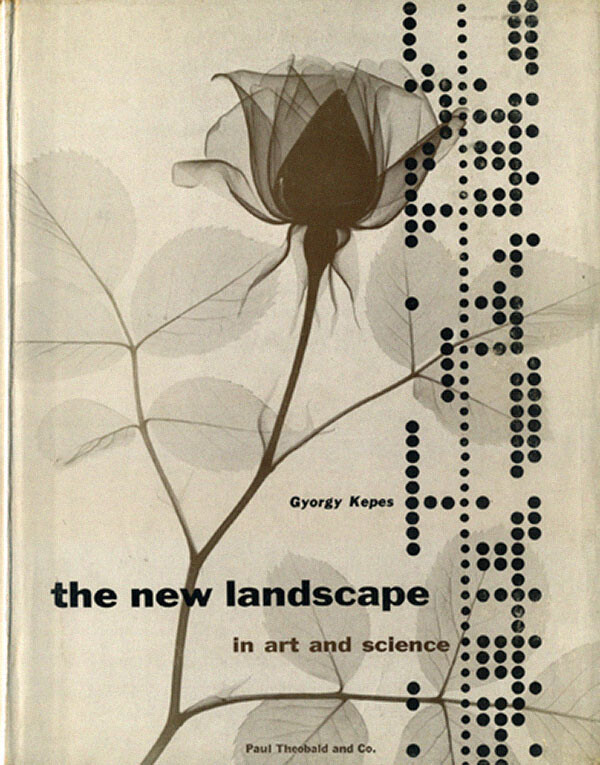

Cover of György Kepes’s 1956 book The New Landscape in Art and Science.
What matters in the reference to Korzybski is not the outdated neuroscience, but the core questions about affective orientation in the gap between map and territory—or, as we would say today, between information and embodiment. This was also the central issue for Moholy’s friend and disciple, the Hungarian painter, sculptor, and graphic artist György Kepes, who came to Chicago to work at the New Bauhaus in 1937. During his years in Chicago, Kepes elaborated the principles of information design that were condensed into his book Language of Vision in 1944. After Moholy’s death, Kepes moved to a position at MIT in 1947, where he would later found the Center for Advanced Visual Studies in 1967.8 At MIT he was exposed to the new scientific and engineering programs developed under the pressures of war. He also absorbed the discourses of information theory and cybernetics, which promised to knit the new sensors and devices together by means of feedback loops that would function as control interfaces, whether for animals, machines, or human beings. Kepes was confronted with a tremendous augmentation of the prosthetics of vision, which he believed could be turned away from pure science and made into the perceptual and expressive organs of a global society in motion. To explore what he called the “felt order” of this new society, he tirelessly gathered the most striking examples of scientific vision and edited them into a strange and powerful book entitled The New Landscape of Art and Science (1956). As he wrote:
Instruments bring us fresh knowledge of the world and further control over nature. With instruments we are gradually finding a common denominator in all sensed experience: it is possible to convert sound to sight, space to time, light to form, and interchange phases and events, static and dynamic, sensible and conceptual. Through modulation of signals we extend experience, letting the blind see, the deaf hear. We can introduce new relations into any set of signals—extending, condensing, distorting, magnifying, reducing. By feeding punched cards into electronic computers linked to nuclear power we might alter our environment to an extent limited only by our own imagination.9
The first thing that leaps out of this passage is the Promethean spirit of modernism, expressed at the height of the Atomic Age. Its consequences are now visible across the earth, not only in the devastated zones of oil and mineral extraction, but also in the great metropolitan centers with their proliferating landscapes of art and science. Indeed, the ecological crisis has been so profound over the sixty years since this text was written, and so broadly tolerated by governments, professional classes, and seemingly anaesthetized populations, that one begins to wonder less about the hubris of the artist’s declarations and more about the way he relates the modulation of signals to the transformation of perception. If information can somehow unleash the faculties of sight and hearing, can it simultaneously contain and direct them? How do signals become sensation? Can they also contribute to anesthesia? What does the alteration of our environment have to do with the limits of our imagination? And most importantly: Where is the link between scientific instrumentation and the question of “emotional orientation” that lay at the heart of Moholy’s “vision in motion?”
In her recent book Beautiful Data, Orit Halpern interprets Kepes’s practice as a crucial site for the elaboration of the cybernetic interface that now structures our world of mobile computing. At the intersection of the techniques of vision, she writes, “the [human] subject was envisioned as a smooth space for the transfer of information between the inner and the outer worlds, between the registers of analysis and stimulus.”10 Her focus is not on the direct control of behavior, but instead on the relocation of both perception and cognition to the mediated space of information storage, processing, and display—a transfer that depends crucially on the subject’s embrace of the constructivist visual vocabulary that both Moholy and Kepes elaborated. The fundamental power of the interface is to draw the subject’s attention and affective investment away from the qualities of the world to which information refers, and toward the qualities of the information itself, its modulation on the screen. For Halpern, this is the “felt order” that emerges from The New Landscape in Art and Science. In the complete form of the cybernetic paradigm as she identifies it there is no difference between stored data, computational logic, and symbolic form, on the one hand, and the “neural networks” mobilizing human expression, on the other. Analysis translates seamlessly into stimulus. Thought itself pulses on the screen.
Halpern’s reading of Kepes is an archaeological dig exposing the foundations of today’s aesthetic regime. To be convinced, just watch someone move through urban space with a GPS-equipped cell phone. At stake in the deployment of locational data, web information, and mobile telephony is a dynamic relation between device, self, and world. The very malleability of the signal-stream—the ease with which you can adjust a few of its parameters—makes the screen into a site of invention where you can alter your inner nature, and outer nature too, like a photographer retouching a digital image. On one level, the cell-phone GPS device is globalized society’s response to the sense of deep disorientation that cultural critic Fredric Jameson diagnosed in the mid-1980s. It offers the individual human body fresh capacities “to locate itself, to organize its immediate surroundings perceptually, and cognitively to map its position in a mappable external world.”11 Yet with the networked compass a change in emotional orientation occurs, toward the interface that guides our interactions with the world, even while turning us subtly away from it. In the process, vision in motion loses sight of the increasingly toxic infrastructure that provides its underlying conditions of possibility. It’s a crucial shift: you begin to live primarily in the beautiful map, rather than the devastated territory. This is the dominant aesthetic condition that the protagonists of an Anthropocene public space must necessarily confront.
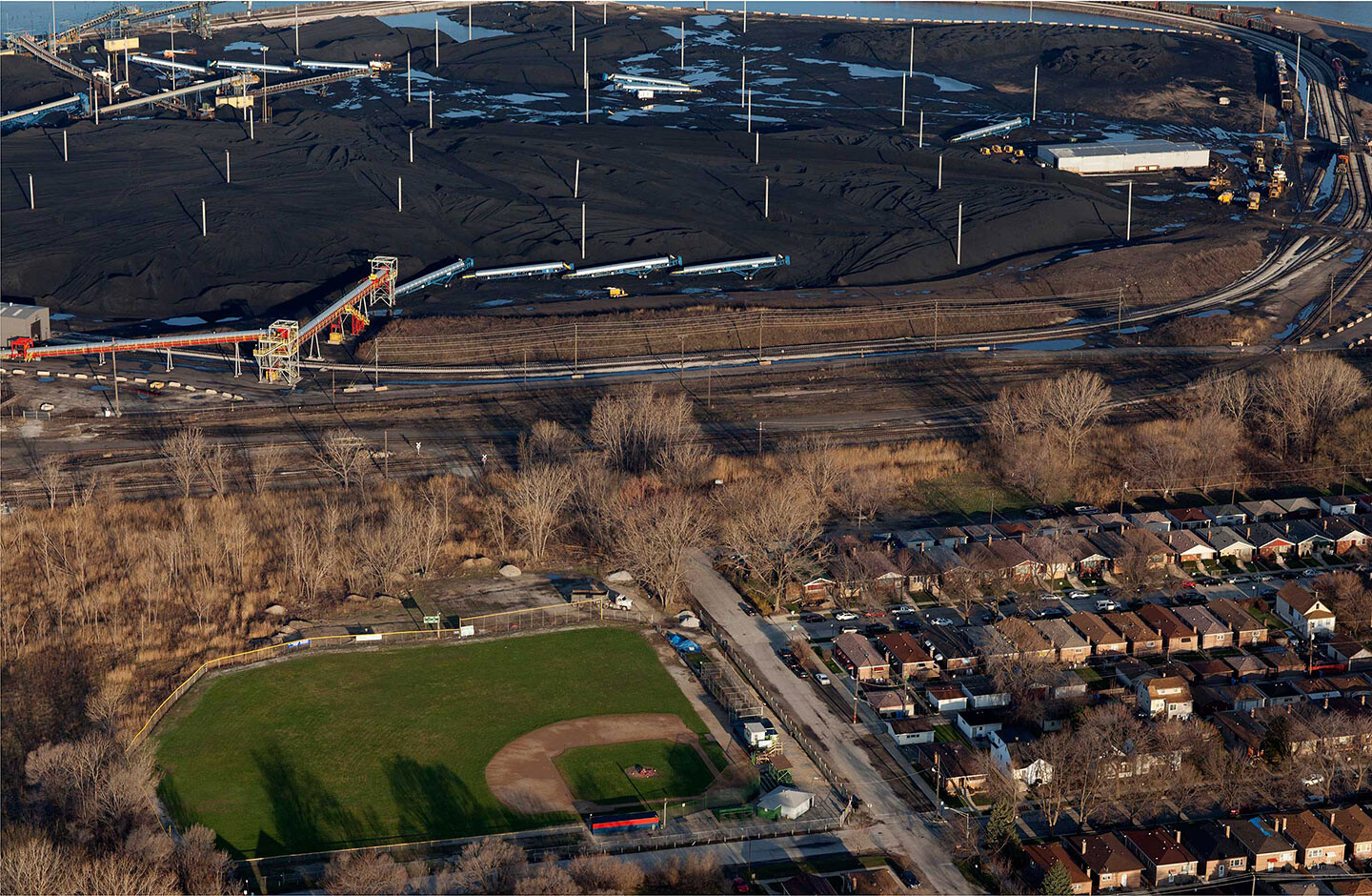

Terry Evans, Koch Brothers Petcoke Pile Near the Neighborhood, 2015.
Huge Dusty Piles
Disasters pierce the retina-bright display. After Fukushima, ordinary citizens began deploying Geiger counters, probing the new nature of a technologically altered world. Yet all the authorities delivered, both inside and outside Japan, was a massive and continuing cover-up.12 More questions arise: Is it possible to exercise our perception in advance of a major breakdown? How would the affects of the onrushing future circulate between individuals and social classes? What forms of expression would arise? What kinds of political relations would be entailed—or curtailed? Would such an exercise in collective perception constitute a new space of experimentation, inspired and demanded by the real conditions of existence in the twenty-first century? And perhaps most importantly: Are such experimental processes underway right now, in more or less isolated spots all over the world?
On August 30, 2013, the wind blew in Southeast Chicago. Neighbors in the ‘hoods looked up to see great black clouds in the sky. To some it looked like a windswept column of smoke from an impossibly large and frightfully nearby fire. To others it looked like the trumpet blast of end times, the suddenly gathered storm of the Apocalypse. One resident, Anthony Martinez, took a photograph that helped lay the basis for regulatory and legal proceedings.13 The substance turned out to be petroleum coke, a residual by-product of oil refining, whipped into atmospheric clouds by unusually strong gusts. Along the banks of the Calumet River, amidst the brownfields of the former steel industry, three dusty piles of the stuff, each several stories high, had accumulated over the course of the preceding year, without most local residents realizing what they were or where they came from. Now the black grime on the windowsills, the gritty dust in the air, and the worsening asthma of the local children became a subject of inquiry across the city, the state, and as far away as Washington, DC.
It is fascinating to experience a shift in collective perception. Inhabitants, environmental groups, the Natural Resource Defense Council, the Chicago Department of Public Health, the EPA, and even some area artists—first of all, the photographer Terry Evans—became involved. Journalists and investigative teams scrutinized the threatening black stockpiles, two of which, it turned out, were being run by KCBX Terminals, a subsidiary of the infamous Koch Industries.14 The riverside piles served as staging grounds for freshly produced material awaiting transshipment. Gradually a crucial fact emerged, which had never been hidden but broadly ignored up to that point. Petroleum coke, or “petcoke,” is a messenger from the Athabasca Tar Sands. It arrives in the form of diluted bitumen sent by pipeline or train from northern Alberta. After refining, the petcoke itself is shipped out for sale, to furnaces in the US as well as foreign countries. The huge black stockpiles, the grimy dust, and the fine particulate matter suspended in the air turned out to be Chicago’s way of participating in the oil sands boom, which has been called “the most destructive project on earth.”15 What appeared to be a local incident was actually a spatial relation at continental and global scales.
Let’s get closer to the thing itself—the aesthetic messenger. When conventionally refined by fractional distillation, the carbon-heavy Canadian bitumen leaves a thick residuum or “resid” that must be thermally cracked at upwards of 900° Fahrenheit in hundred-foot-high drums known as “cokers.” The cracking process yields new feedstocks for further distillation, as well as a hard, glassy precipitate, the petcoke, which is cut out of the drum using high-pressure hoses and dumped into concrete chutes, from which it is typically removed by conveyor belts to railroad cars or barges. Priced to move, petcoke is a cheap and dirty fuel, heavily laden with sulfur, nickel, and vanadium. When it is burned in power plants, whether in the US itself, Latin America, Turkey, or all across Asia, it exhales five to ten percent more greenhouse gases per unit of energy generated than coal, which is accounted as the single worst driver of climate change. Its ultimate “message” is CO2: colorless, odorless, intangible, invisible. Unfortunately for the atmosphere, every barrel of tar sands bitumen produces from fifteen to thirty percent petcoke, which is sold by the refineries to be burnt in furnaces, mainly as a coal replacement.16
The total petcoke production of US refineries is now some 175 thousand tons a day (64 million tons a year). In 2012, all three Chicagoland refineries—BP Whiting, Citgo Lemont, and ExxonMobil Joliet—upgraded their cokers to take advantage of cheap Canadian tar. These three refineries alone process about a quarter of the bitumen refined in the US.17 What the piles have revealed is that Chicago is Tar Sands Central: the biggest single market for the single most damaging petroleum project on earth. Yet that in itself is a chance for perception. The stripping of the boreal forest, the pollution of the Athabasca watershed, and the inexorable rise in the CO2 composition of the earth’s atmosphere can be seen, touched, and tasted along the banks of the Calumet River.
Can a waste product marketed as a valuable fuel be treated proactively as both a clear and present danger and as a public monument? Such an approach is suggested by current philosophy and cultural critique. The materialist turn toward the “agency of things, “vibrant matter,” and “speculative realism” is driven by a need to come to grips with the suicidal overproduction that structures contemporary society. In this regard Timothy Morton’s book Hyperobjects is the most explicit. From its perspective, the handful of petcoke that you can pick up along the side of the river becomes the withdrawn index or impossible clue to the vast interlocking system of energy production and its consequences, on the scale of the planet earth and in the dimension of geological time.18 The earth-systems scientist Peter Haff is equally challenging. He defines the “technosphere” as a machine network of global extent, comprising “the world’s large-scale energy and resource extraction systems, power generation and transmission systems, communication, transportation, financial and other networks … including computers, windows, tractors, office memos and humans.”19 For him, the crucial problem is the disconnect between human agency and planetary scale. You participate in the operations of the technosphere and your input is essential to them; but nothing that can be done at individual scale is capable of changing their inexorable course. In this analysis there is a vertiginous gap where politics once resided.
In Chicago, as in nearby Detroit where a similar dusty pile had appeared in 2012, civil society went quickly into action, translating grassroots protest into municipal regulations. One stockpiler, the Beemsterboer Slag corporation, was found to have been working for a year without a permit and was rapidly closed down. In early 2015, the BP Whiting refinery announced that from midsummer onward it would no longer send its petcoke to local terminals. KCBX then retreated from one of its sites, to concentrate operations at a single, more efficient location. The installation of fugitive dust monitoring equipment was imposed on all the entities maintaining open stockpiles along the Calumet River, opening up a period of uncertainty while the details of the new regulations were worked out and tested. In June 2016, just before the art exhibition “Petcoke: Tracing Dirty Energy” was installed in a downtown museum, KCBX ceased its dusty stockpile operations and shifted to a much-reduced form of activity, transloading directly from train to ship. A small but significant victory had been won.20 Yet as important as this was locally, it does nothing about the underlying dynamics of tar-sands exploitation or the larger climate disaster. The whole situation demands a much broader struggle—including a more radical change of both politics and aesthetics.
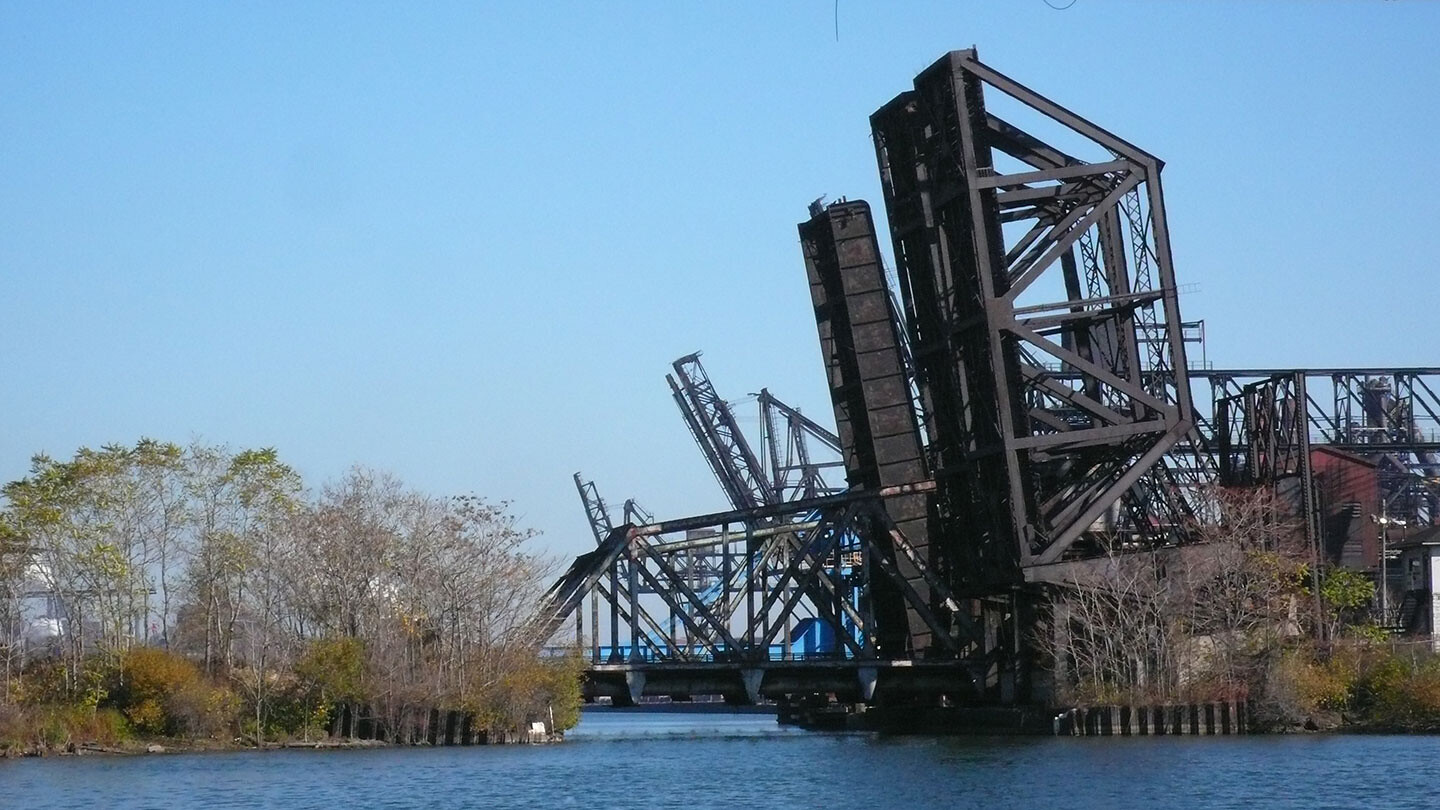

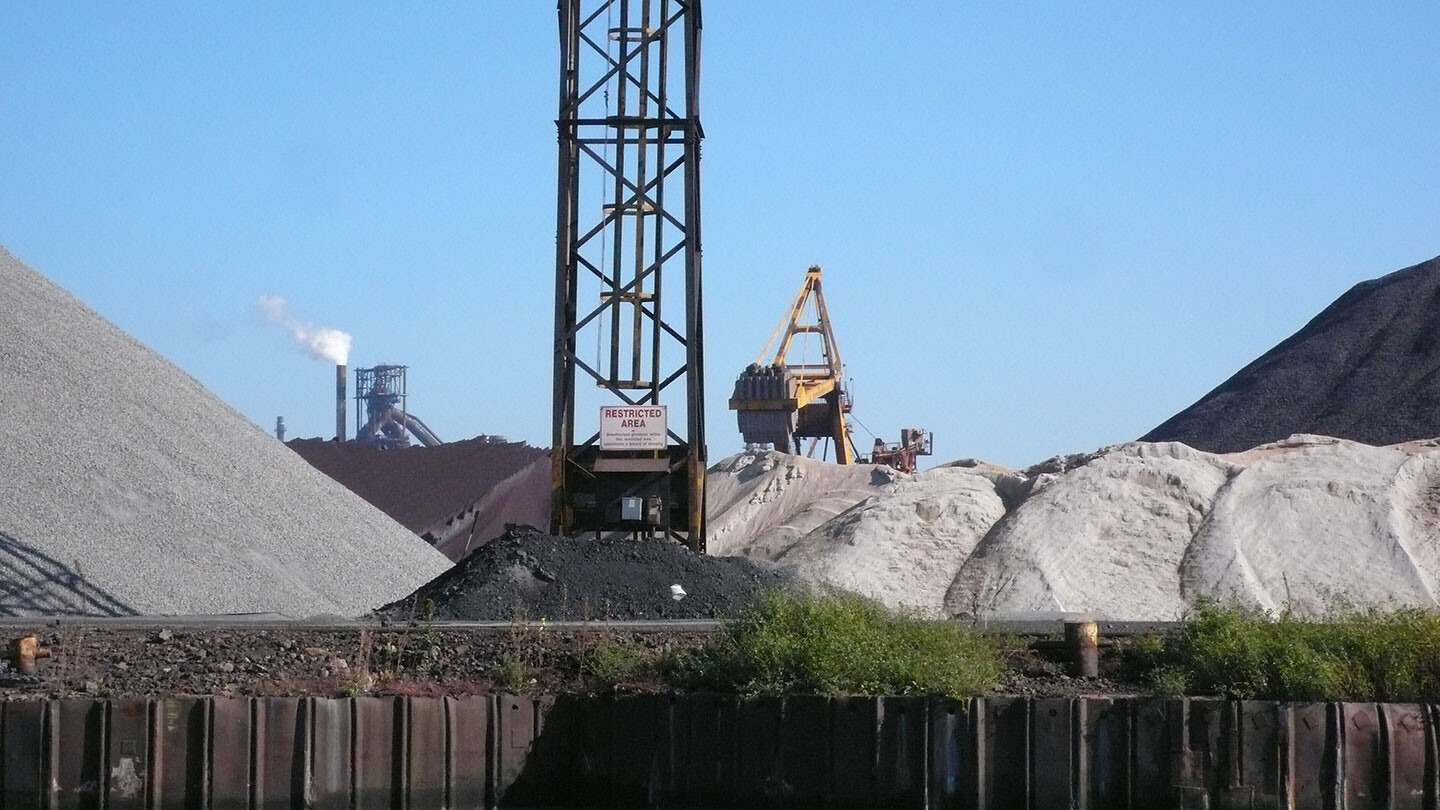

Brian Holmes, Indiana Harbor Bridges and Anthropogenic Landscape, 2015.
Geological Layers
A century ago, Moholy-Nagy became an artist in response to the industrial slaughter of World War I, which he experienced firsthand as an Austro-Hungarian artillery officer on the Russian front. To face the destructive powers of technology, he adopted a constructivist ethos that seeks to build out utopia into reality.21 His preoccupation, however, was not architecture itself, but instead the modulation of spatial relations through expressive form. To this end, he spent years making a motorized “Light Prop for an Electric Stage” (completed 1930).22 It was composed of glass panels and independently rotating chromed metal grids designed to cast large mobile shadows on the walls of a room, while simultaneously dazzling the viewer with chance reflective gleams. The effect, whether of the device itself under colored lights or of its filmic translation—“Light Play: Black White Gray” (1930)—was to multiply the viewer’s capacity to perceptually explore and affectively fill the complex architectural volumes shared with passing crowds in the modern city. Created in collaboration with a draftsman/engineer who was also employed by Walter Gropius, the piece can be seen as the culmination of Moholy’s experiments in the Bauhaus metal workshop. The transformation from “material volume … into virtual volume” and from “mass to space-time relationships” lay at the core of the teaching that he brought to the Institute of Design in Chicago.23 Some crucial components of this teaching, I would suggest, can still be found in the ecological experimentation of the present. But only some of them.
On days when the wind is calm one can venture in a small boat over the waters of Lake Michigan to the Indiana Harbor where the largest remaining steel mills are located. I did this for the first time one unseasonably warm November morning in 2015. As you pass the flaring BP refinery, the skyline built by Mies van der Rohe and his followers in the decades after Moholy’s death gradually recedes into the distance. The harbor mouth opens up at the end of a long, jutting peninsula, dark and without vegetation. All this land, hundreds upon hundreds of acres, is entirely artificial, made of slag and debris cast off by the foundries where the bones of the skyscrapers were forged. Huge cranes and girdered railroad bridges, painted black against the rust, define the contours of the narrow channel leading to the heart of the complex. On the day of my journey the steelworks themselves, now managed by the Indian conglomerate Arcelor-Mittal, lay weirdly quiet beneath the bright autumn sun, chimneys still smoking, idled by the ongoing recession. Metal retaining walls sunk beneath the surface of the water outlined the new areas that will be filled soon, if activity resumes. This is an Anthropocene landscape, a new geological layer sedimented on the crust of the earth. The global economy implodes here, transforming the territory and the inhabitants, before it is expressed and put into circulation once again as finished products and undesirable wastes. Like the strip-mined forests of northern Alberta, this is a place that seems to demand a shift in our attention, so that “material volumes” can themselves be understood as “space-time relationships.”
I let the boat drift back out to the harbor, feeling my way into the disorienting surround. The eerie calm of the steel mills reminded me how the city had functioned as a giant extraction machine that actively profited from the conflicts between immigrants, first by pitting groups of workers against each other, then by making battles over neighborhood turf into the driving forces of both suburban flight and vertical housing projects. Racism, or the violent domination of whites over blacks, became the central affective force driving everyone to succeed, to individualize, to escape, to accumulate wealth and power, to participate in endless imperial growth. Today in Southeast Chicago those dynamics are spent and stratified, leaving the industrial areas around the refinery and along the Calumet River as forgotten sacrifice zones, relegated to the increasingly automated post-processing of more distant conflicts. Now the action has moved to the downtown Loop and the technology corridors of the suburbs, where the big data of the global financial economy is analyzed for strategic advantage, then transformed into symbolic by-products for circulation on proliferating electronic interfaces.24 For a few clusters of people—inhabitants, local activists, engaged journalists and artists, public health workers, and officials of the perennially embattled EPA—the intrusion of a toxic waste material into the ruined riverside landscape has acted to disrupt the prevailing patterns. The question is how to provoke further, larger, more sustained disruptions—and what to do with them.
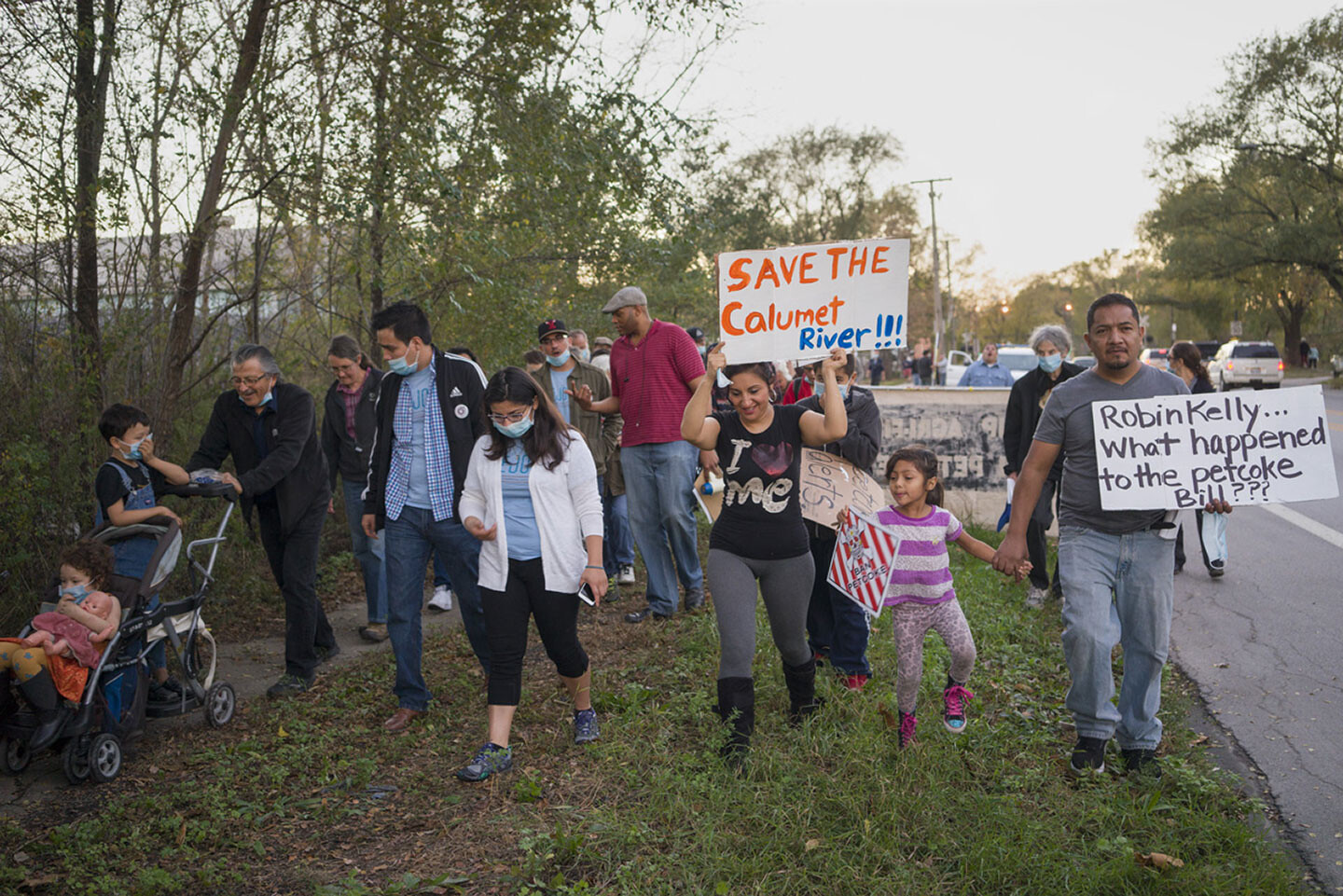

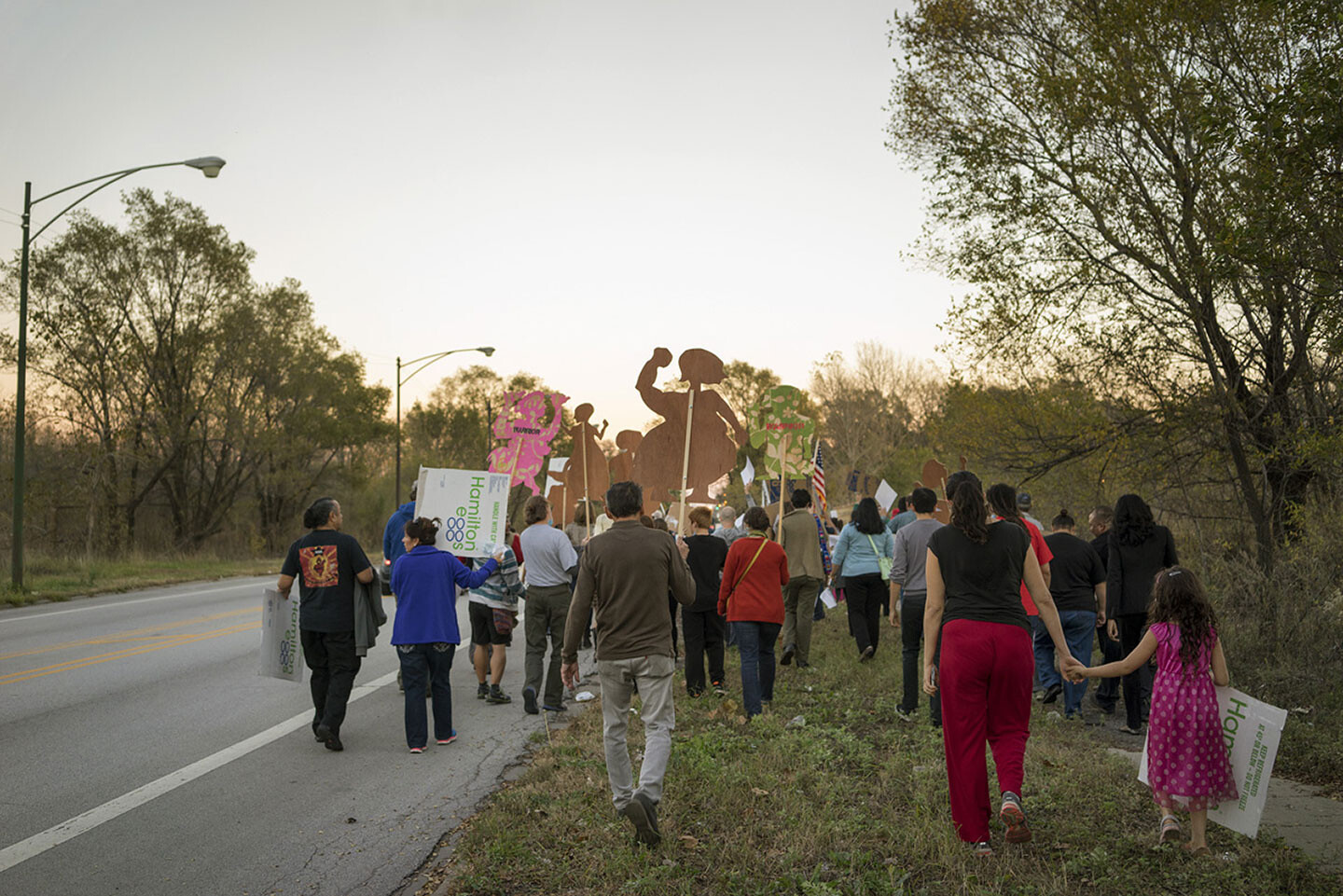

Terry Evans, Ban Petcoke March on Southeast Side, November 2015, 2015.
Technology is still “as much a part of life as metabolism,” as Moholy put it in Vision in Motion. But the meaning of that statement has changed entirely since the middle of the last century. Bauhaus modernism sought to train the individual for emancipation through technology. Contemporary social movements seek to dislodge the abuses of technology from their foundational places in the economic system, and indeed, in the psyche. Today, experimental social formations articulated across divides of class, race, education, and professional specialization can find ways to perceptually explore and affectively modulate the environments, or better, the political ecologies in which their own pulse beats and their own lives unfold. To do so, they have to step outside the charmed circles of the city center and the attractions identified for them through the application of big data. The exaltation of “vision in motion” now translates all too easily into a kind of addiction to the malleability of a private self experienced on corporate screens. A retreat from the urban realm, however, can do little to fill the vertiginous gap where political responsibility once resided. Only at the metropolitan scale can one perceive and actually touch the vast system of spatial relations that produces climate change. By examining what the urban space internalizes, reprocesses, and expresses—that is, how it co-creates the “technosphere”—we begin to understand our own implication in what Marxian ecologists call “the metabolic rift,” or the contradiction of biogeochemical cycles that human action has damaged, but could at least partially repair.25 This idea of “partial repair” is not about restoring some long-lost unity of nature. But it is about addressing urgent, proximate issues of racism and environmental justice, while at the same time preparing for a difficult future in which life will nonetheless go on.
Since the beginning of the Industrial Age, the geological sediments of the Anthropocene have been laid down by successive boom-bust cycles of economic growth that last from fifteen to twenty-five years, before they are interrupted by periods of relative global slowdown. Exactly that sort of slowdown is occurring now, as I could observe with my own eyes from the boat in Indiana Harbor. However, an important tradition in the study of industrial innovation shows that periods of relative calm have always given way to fresh winds of political-economic change. After each “great recession,” new technologies and organizational forms become the object of great surges of investment that alter society in fundamental ways.26 The last growth wave, generally known as neoliberalism, was devastating for the planetary ecology, as was the preceding phase of Fordism. It would be difficult to exaggerate the importance of the next growth wave, in its cultural components as well as its industrial ones. How to map out a possible transformation? How to live it out on the urban territory? Can the networked compass be repurposed? Can our civilization change the character of its destructive toolkit?
Moholy’s central insight concerned the role of aesthetics in shaping the individual’s relation to the spatial surround, both technological and social. Like Korzybski, he believed that a disjunction between abstract ideas and the affective register of perception/expression led to an unhealthy condition—literally, insanity. The Institute of Design in Chicago, like the Center for Advanced Visual Studies under Kepes at MIT, sought to reintegrate the abstractions of scientific knowledge into the “felt order” of aesthetic experience. Today that core ambition needs to be revived, but also reevaluated. The developments of cybernetically managed communications technology since the emergence of ubiquitous computing have shown the possibility of a thoroughly affective euphoria of mobility, perceptual agility, expressive virtuosity, and relational fluidity amidst steady progress toward complete ecological breakdown. The interface aesthetic is literally a dead end. It is now urgent to invent the perceptual and expressive techniques whereby urbanized populations can become conscious of, and take responsibility for, the global spatial relations of their own metropolitan territory. This must be done very concretely, in contact and dialogue with other inhabitants. Respect is when you change your own life. Public space is where you share that possibility.
For geologists, the “golden spike” is an intervention into the stratigraphic record, pointing to a particular rocky cutaway that displays all the crucial features of a transition between two epochs. For artists and activists seeking to transform the conclusions of climate science into the convictions of embodied experience, the golden spike is each local place and singular moment in time when a group of people is able to come to grips with their own implication in earth-system processes. Because abstract knowledge is always intertwined with embodied experience, such places and moments in time are never purely local or singular. To take form and consistency as a widely sharable practice of perception/expression, Anthropocene public space must seek the correlation of situated knowledges and experiences. Driving home the golden spike of climate change, and of the crucial technopolitical choices it lays before us, is the intellectual and aesthetic responsibility of the present.
László Moholy-Nagy, Vision in Motion (Chicago: Paul Theobald and Company, 1947), 64.
Jürgen Remane, “Chronostratigraphic correlations: their importance for the definition of geochronologic units,” Palaeogeography, Palaeoclimatology, Palaeoecology 196 (2003): 7–18. Quoted in A Geologic Time Scale, eds. Felix Gradstein, James Ogg, and Alan Smith (Cambridge: Cambridge University Press, 2004), 23.
Will Steffen, Paul J. Crutzen, and John R. McNeill, “The Anthropocene: Are Humans Now Overwhelming the Great Forces of Nature?” Ambio 36, no. 8 (2007).
Ibid., 617–18.
Moholy-Nagy, Vision in Motion, 58.
Ibid., 11
Ibid., 30. Moholy (or his posthumous editor, Sibyl Moholy-Nagy) falsely attributes the first quote to Korzybski himself; the source is in fact Oliver Bloodstein, “General Semantics and Modern Art,” ETC: A Review of General Semantics 1, no. 1 (1943): 16. It may also be pointed out that unlike Moholy, Bloodstein had no interest in any orientation with respect to any territory, except that of abstract modern art itself.
For his life and work in the period, see the exhibition catalogue Gyorgy Kepes: The MIT Years, 1945–1977 (Cambridge, MA: MIT Press Visual Arts Series, 1978).
György Kepes, The New Landscape in Art and Science (Chicago: Paul Theobald and Company, 1956), 173. The same passage is quoted by Reinhold Martin in the opening pages of The Organizational Complex: Architecture, Media and Corporate Space (Cambridge, MA: MIT Press, 2005), which is one of the key sources for the book by Orit Halpern discussed below.
Orit Halpern, Beautiful Data: A History of Vision and Reason since 1945 (Durham, NC: Duke University Press, 2014), 138.
Fredric Jameson, “Postmodernism, or The Cultural Logic of Late Capitalism,” New Left Review 1, no. 146 (1984): 83
See the article by Karl Grossman, “’No one died, no one’s health was damaged’—Fukushima’s big lie,” The Ecologist, March 8, 2014 →. The text is only one of many intensely critical reactions to the World Health Organization’s 2014 declaration: “Outside the geographical areas most affected by radiation, even in locations within Fukushima prefecture, the predicted risks remain low and no observable increases in cancer above natural variation in baseline rates are anticipated.” See the report at →.
For the photograph and the story, see Ben Whitford, “Petcoke: the toxic black dust coming to a community near you,” The Ecologist, December 9, 2014 →.
For an excellent photo-reportage by Zbigniew Bzdak, see “Photos: Petroleum coke and the BP Whiting refinery,” Chicago Tribune, October 18, 2013 →.
Christopher Hatch and Matt Price, Canada’s Toxic Tar Sands: The Most Destructive Project on Earth (Toronto: Environmental Defence, 2008); pamphlet available at →.
Cf. Lorne Stockman et al., Petroleum Coke: The Coal Hiding in the Tar Sands (Washington, DC: Oil Change International, 2013); pamphlet available at →.
For a 2012 estimate of where tar sands oil was refined in the US, see →.
Timothy Morton, Hyperobjects: Philosophy and Ecology after the End of the World (Minneapolis: University of Minnesota Press, 2013).
Peter Haff, “Humans and technology in the Anthropocene: Six rules,” The Anthropocene Review 1, no. 2 (2014): 127.
For firsthand documentation of the conflict and a look at the activism and art developed in response to it, see the exhibition catalog Petcoke: Tracing Dirty Energy (Chicago: Museum of Contemporary Photography at Columbia College, 2016). An online map/archive, created by the author of this text and featured in the exhibition, attempts to situate the conflict within a larger play of spatial scales, while simultaneously grappling with the derealizing effects of the dominant interface aesthetic: see →.
For firsthand documentation of the conflict and a look at the activism and art developed in response to it, see the exhibition catalog Petcoke: Tracing Dirty Energy (Chicago: Museum of Contemporary Photography at Columbia College, 2016). An online map/archive, created by the author of this text and featured in the exhibition, attempts to situate the conflict within a larger play of spatial scales, while simultaneously grappling with the derealizing effects of the dominant interface aesthetic: see →.
For the formation of this ethos, see the first chapter of Sibyl Moholy-Nagy, Moholy-Nagy: Experiment in Totality (Cambridge, MA: MIT Press, 1950/1969), especially the excerpts from Moholy’s text “Constructivism and the Proletariat” (1922), 19.
Moholy-Nagy, Vision in Motion, 241.
On the development of electronic derivatives trading in the city, see my text “Information’s Metropolis: Chicago and the New Nature of Global Finance,” in Beate Geissler & Oliver Sann and Brian Holmes, Volatile Smile (Moderne Kunst Nürnberg, 2014).
For the recovery of this concept from historical oblivion, see John Bellamy Foster, Marx’s Ecology: Materialism and Nature (New York: Monthly Review Press, 2000).
For a synthesis of long-wave theory from Kondratiev and Trotsky to Schumpeter and Carlota Perez, plus applications to the present, see my article “Crisis Theory for Complex Societies,” in Disrupting Business, eds. Tatiana Bazzichelli and Geoff Cox (New York: Autonomedia, 2013), 199–225; also available at →.
Category
Subject
This essay was inspired by preparatory work for the Anthropocene Curriculum program at the Haus der Kulturen der Welt in Berlin and for the exhibition “Petcoke: Tracing Dirty Energy” at the Museum of Contemporary Photography at Columbia College in Chicago. Heartfelt thanks to the friends and collaborators of those events, to the community activists of the Southeast Side, and to the members of the Compass group with whom I have worked for roughly a decade. Your thought and daily practice provides the basis for what has been expressed here.
This text is published under creative Commons: Attribution-NoDerivatives 4.0 International (CC BY-ND 4.0) license.

